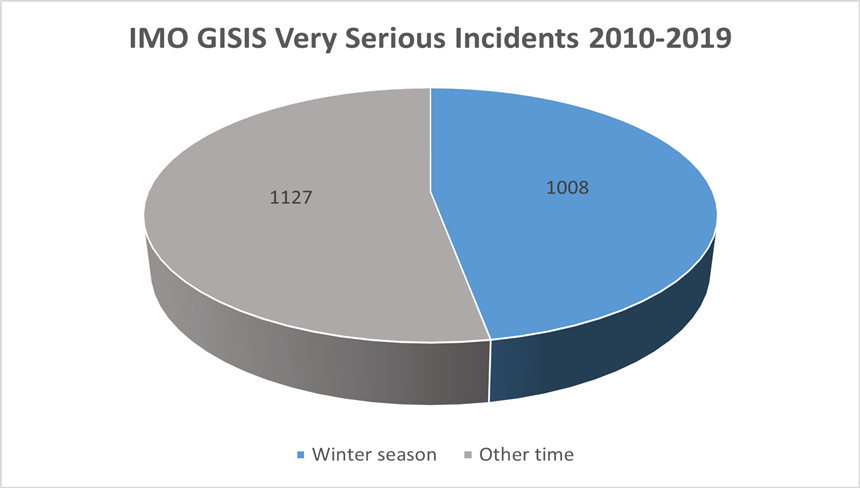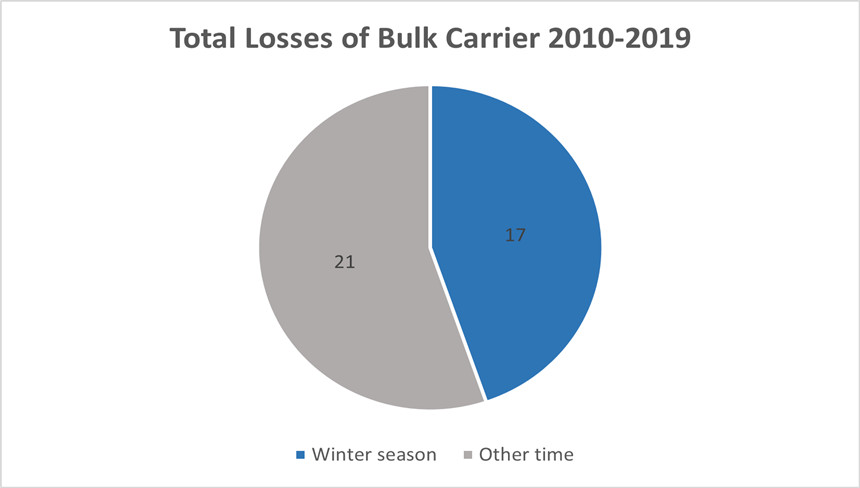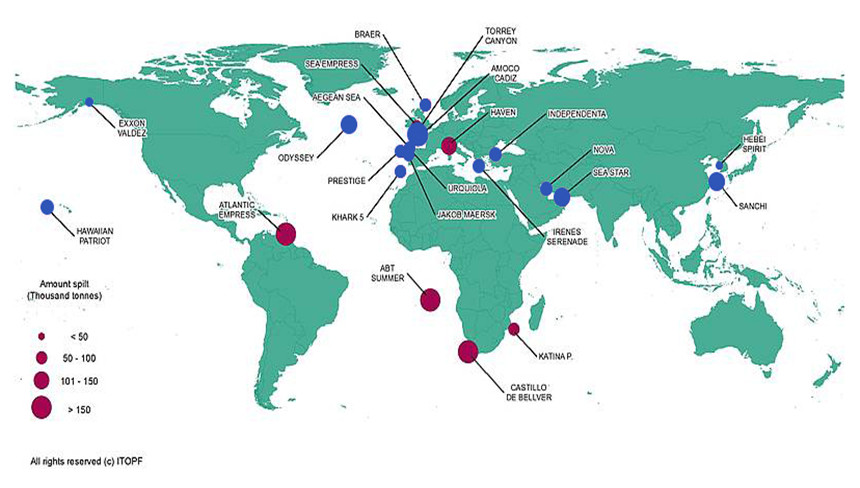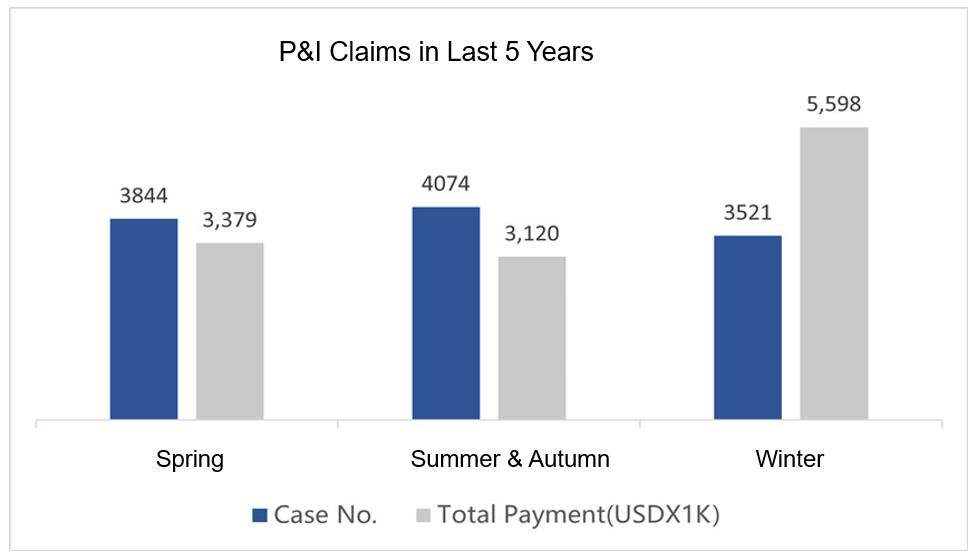LP 73/2020 Winter is Coming: Safety Guide for Ship Navigation under Heavy Weather
The winter in the northern hemisphere usually lasts from November to March. The cold air affected by the high pressure pushes down from the North Pole, bringing a harsh and dry weather. Condition at sea can be more severe and unpredictable with winds and waves, steam fog and ice floes all being great challenges to the navigation of ships. Groundings, collisions, cargo loss and damages are frequently seen in winter with an increased rate of personal injuries and death in severe conditions.
I. Incidents in winter
n IMO GISIS Data
According to the IMO GISIS database, among the 2135 severe maritime incidents over the decade from 2010 to 2019, 1008 (about 50%) took place in winter between November and March, a figure much higher than that in other seasons.

n INTERCARGO Casualty Report
The INTERCARGO Bulk Carrier Casualty Report released in May 2020 provided detailed information on casualty statistics covering the last ten years. It turns out that about 50% casualties were too in the period between November and March.

n ITOPF Major Spills
A summary of the top 20 major spills that have occurred over the years is given on the ITOPF official website. Some incidents that are already familiar to the public – Prestige, Exxon Valdez, Amoco Cadiz and Sanchi – are also included. In the below map of location of these major spills, 16 incidents that happened in winter are marked out in blue dots.

n CPI P&I Cases
By going through all the cases handled by the Club within the period between November to March each year for the last five years, the author finds that these cases, compared with cases occurred in other seasons, show no sign of increase in number but a surge in the amount of compensation. In terms of types of these cases, ship collision and personal injury claims are significantly higher than other periods, meaning the probability of severe maritime incidents remain high in in winter.

II. Navigation in winter
Ship maneuvering and collision avoidance can be challenging for ships navigating in winter especially with the low temperature and heavy storms. Cargos and containers may be displaced or fall overboard in the rolling sea; judgement and actions of crew members may be affected in freezing weathers, all suggesting a higher risk of casualties.
l Small objects in heavy storms like fishing boats and sailing boats may not be detected either by visual lookout or radar devices, enhancing navigation hazards.
l Steam fog may be formed at nearshore waters or at sea as cold air moves down over warmer water, undermining the visibility.
l Navigation in rough weather may result in reduced rudder efficiency, propeller racing, mechanical failures and damages to hull structure – the malfunction of radar and communication equipment e.g., and displacement of fire and rescue equipment which are exposed in air.
l It can be hard for navigating officers to stay focused in extremely cold climates and there can be severe consequences of grounding and collision incidents if they lose reasonable judgement.
l Damages can be done to hull, engine, rudder and anchor when navigating in ice covered waters.
l Cargos tend to move a lot at the rough sea as the result of improper stowage and lashing, leading to cargo damages and loss and in severe cases, damage to the hull and overturn of the ship.
l The coldness may slow down cargo operation and therefore increase the operation cost. Transportation of liquid cargo at very low temperature can be risky as well.
l The dry conditions and steady winds in winter are prime ingredients for potential fire hazards.
l Crew members and workers may suffer frostbite in winter and may be clumsy for wearing heavy boots and clothes – stevedores may fall over wet and slippery deck or pilots may fell overboard.
l Both New Year and the Chinese New Year come in winter. Extra care should be given to those stay on board during holidays, especially with the COVID-19 situation.
III. Safe navigation advices
Based on above facts and statistics, the Club would like to remind our Members to take precautions for navigation in winter from the perspective of ship, cargo and person.
l A designated crew member should be assigned to collect weather forecast and confirm weather routing information so that a safe and reliable voyage plan can be formulated.
l Keep a proper lookout at the bridge and remain vigilant for approaching vessels.
l Regularly check and keep the navigation aids at the bridge including antenna in good working condition.
l When there’s icing on deck in rainy or snowy days, the radar should be kept on to prevent the antenna from being frozen.
l Necessary maneuvers should be made to minimize hull damage and avoid wave crash over the stern.
l Make sure cargo hold hatch covers and doors are securely closed to prevent cargo damage by water on deck.
l Have all cargo lashings checked and tightened as necessary in stormy weather.
l Deck crew members should carry out work in an organized way and take care of each other. Avoid going out of accommodation in heavy weather conditions if it is not necessary.
l The master and company should look out for the emotional changes of the crew and arrange recreational or sport activities from time to time to relieve their pressure and improve team bonding.
For more information, please contact your manager at the Club.
